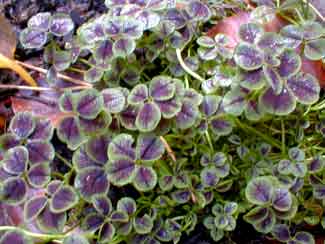
'Dark Dancer'
Black Four-leafed Clover
"Room for a soldier! lay him in the clover;
He loved the fields, & they shall be his cover;
Make his mound with hers
who called him once her lover:
Where the rain may rain upon it,
Where the sun may shine upon it,
Where the lamb hath lain upon it,
And the bee will dine upon it."
-Thomas William Parsons
(1819-1892)
(1819-1892)
Trifolium repens var atropurpureum 'Dark Dancer' Back Four-leafed Clover, Black Shamrock, or Bronze Dutch Clover, is an ornate clover cultivar. Smaller than regular wild white clover, it stands four inches tall. Each leaflet is chocolate-brown to purple-black ringed with jewel-green. The regular variant "Atropurpureum" apart from the unusual color of the leaves is otherwise a regular three-leafed clover, but 'Dark Dancer' is a four-leafed form.
It can spread as far as it's permitted. It is strongly evergreen here on Puget Sound (Zone 8), but can be grown down to Zone 4 where it will be a die-back perennial. The flowers of the species are white, but 'Dark Dancer' has pinkish flowers in globe-shaped summer racemes.
It prefers sun with only a little shade in moist well-drained & rich soil, but will do fairly well in less than ideal conditions. It can also be grown in the lawn, & makes an excellent filler for container plantings.
It is by & large disease free, but if it does get powdery mildew or other fungal problems, it should be shorn to the ground, the shorn bits discarded rather than composted, & allowed to start over.
Eve was said to have brought one plant with her when she left the Garden of Eden, & that was a four-leafed clover. Since Christians have taken the normal three-leafed clover or three-leafed oxalys (shamrock) to represent the Trinity of Son, God, and Holy Ghost (that last being the "Mother" of that divine family, according to Gnostics), it is curious that three-leaf clovers aren't the ones regarded as lucky. It makes one wonder if it was a later pagan invention that the rarer four-leafed strains were luckier than clovers the pagan-slaying Christians were gaga about. It seems feasible that the same medieval & early Irish who saved four-leaf clovers for their ability to repel mischief-making pixies, might also have believed four-leaf clovers protect against violent missionaries.
Leprechauns were supposed to have whole gardens of four-leafed clovers at the ends of rainbows, where also they hid their gold. According to a child's game, the first leaf is Hope, the second is Faith, the third is Love, & the fourth is Good Luck. Neo-pagans prefer the assumption that the four leaves represent the four elements & their presiding divinties: Earth, with the goddess Dana; Water, with the god Lyr; Wind, with the god Njord; & Fire with the sun-god Lugh.
Irish immigrants brought these superstitions to North America. In Appalachia it was believed if you put a four-leaf clover in your shoe, the first person you met (presumedly of the opposite gender) would become your husband or wife.